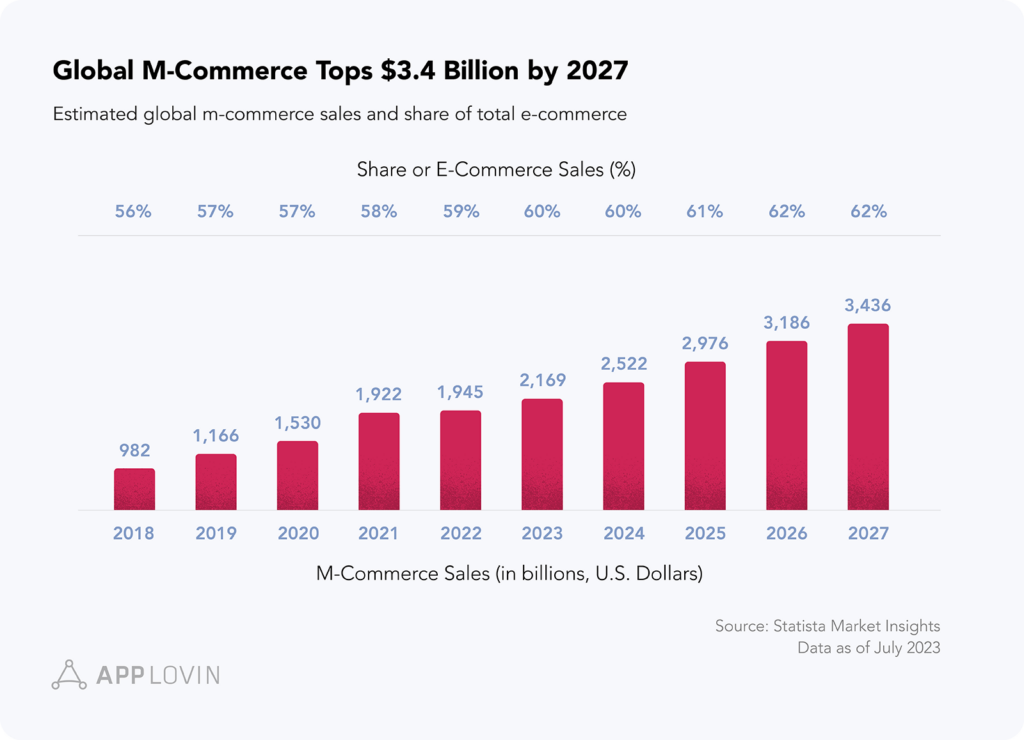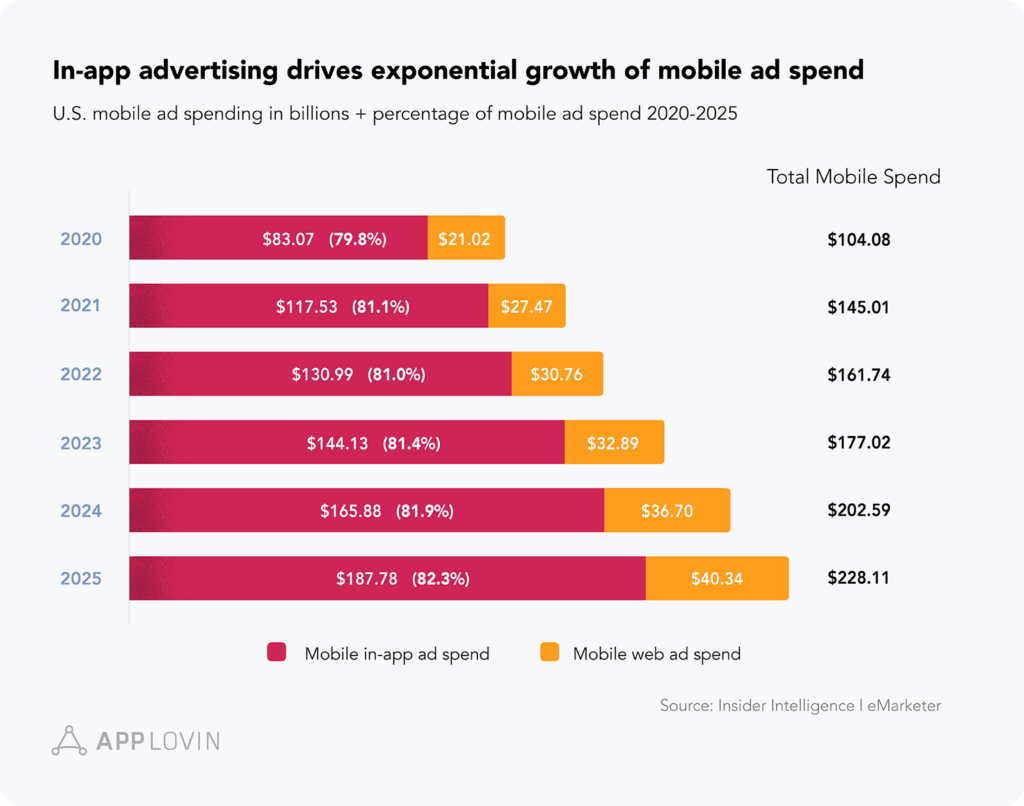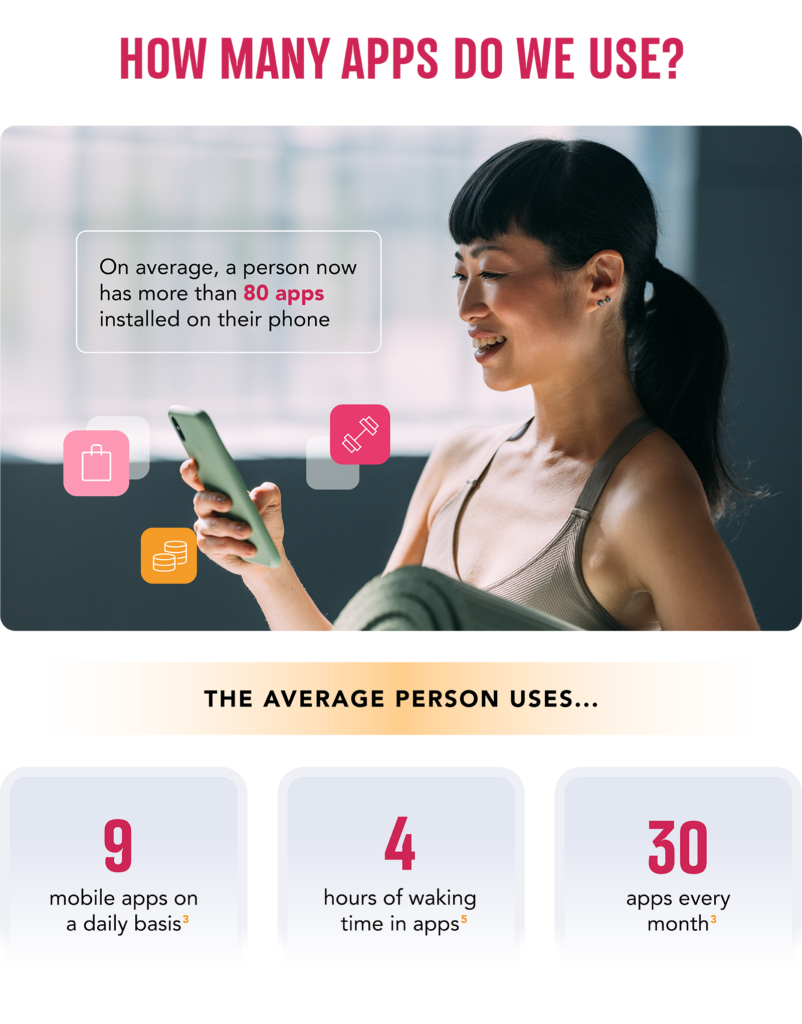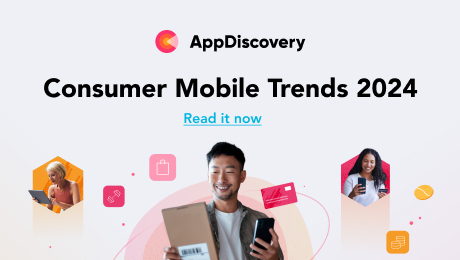Introduction
Consumer habits are trending toward mobile, and apps have become a part of our everyday lives—it’s where we shop, bank, unwind, and more. As such, mobile advertising has become one of the most effective ways for brands to diversify their marketing channel mix to reach consumers. Mobile in-app advertising offers an advantage to access these untapped audiences and discover new growth for consumer businesses.
A growing number of brands are finding success by diversifying their strategy to include in-app advertising. This allows them to reach consumers in areas where competition is less intense compared to channels like social.
AppLovin, the leading marketing platform for business growth, developed this report to show why there has never been a more crucial time for consumer mobile and direct-to-consumer brands to meet audiences where they are—in their mobile apps. We’ll also share the framework for starting and scaling in-app advertising within a brand’s marketing mix.
Key Takeaways
Shifts in consumer behavior impact mobile spending.
As reliance on mobile devices increases, consumer spending has reached unprecedented levels. Brands need to make sure they’re meeting their customers where they are.
Marketing channel diversification helps consumer brands stand out from the crowd.
Users spend 25% of their time in apps, giving marketers a competitive edge in engaging them. Mobile connects brands with customers more effectively, ensuring ads aren’t lost in the clutter.
Mobile in-app advertising delivers untapped scale.
Consumer brands can reach over 5 billion global smartphone users every day; that’s scale rivaling any other marketing channel.
Brand safety is a built-in function of mobile advertising.
App stores thoroughly review the apps on their platforms while many in-app ad formats have 100% share-of-voice, which minimizes the risk of appearing alongside unsafe content.
Incorporating mobile into a multi-channel strategy is simple and delivers measurable results.
Advanced campaigns target consumer behaviors across apps to optimize toward business goals. AI automates this process with precision to deliver the right message at the right time to the right customer.
Consumer Behavior Shifts Fuel Mobile Spending
It’s no secret that consumer behaviors are becoming more mobile-centric. Nearly 50% of online transactions occurred on mobile devices this year and will grow to 62% by the end of 2025, highlighting consumers’ preference for mobile shopping. Global m-commerce sales are projected to top $2.52 trillion in 2024, up 16% from last year.

Savvy app marketers and direct-to-consumer (DTC) brands following this trend (and the money) are increasingly opening their marketing channel mix to include mobile and because of that, mobile advertising revenue is growing. U.S. mobile advertising spend, specifically in-app advertising, is expected to grow to over $200 billion (+15% Y/Y) and increase globally to $400 billion (+11% Y/Y) by the end of this year.

Consumers rely on the convenience that mobile brings to their daily lives whether they’re on the move or relaxing at home. These interactions extend beyond search and social media; they happen within mobile apps.
The Strategic Need for Marketing Channel Diversification
Today, consuming goods and services on mobile is much more commonplace, so a mobile user acquisition strategy is key and delivers a competitive advantage for growing any consumer business.
According to Sensor Tower, global mobile app downloads will hit 181 billion with consumer spending forecasted to reach $233 billion in 2026. This audience is also highly connected to their apps, spending an average of four hours within them. Comparatively, users are spending about 2.5 hours per day using social platforms. By diversifying beyond social, marketers can create more touchpoints by placing offerings in front of consumers across the various apps they use daily – reaching them beyond their social media scrolling.
While social media continues to be an important way to reach new users, it is highly competitive and often oversaturated with ads, accounting for a disproportionate amount of ad dollars relative to consumer engagement. Connecting with users outside of this marketing channel maximizes scale, improves efficiency, and minimizes risk.
Marketers can no longer ignore the opportunity that mobile apps present to reach their ideal customers at the times and frequencies that increase their likelihood of engagement.
Mobile In-App Advertising Delivers Significant Scale
Today, over 5.6 billion people have a smartphone with a mobile subscription, representing 69% of the world’s population. These users engage with apps in various ways.

Consumer apps, in particular, are seeing a significant surge in usage and mobile spending.

By 2025, mobile payments will account for 79% of all digital transactions, with the market projected to reach $607.9 billion by 2030. Banking app users are expected to exceed 3.6 billion this year.2

Global m-commerce sales are projected to hit $2.5 trillion in 2024, representing 60% of total e-commerce sales, with 100 billion hours spent in shopping apps worldwide in 2023.2

Health and fitness apps generated $4.45 billion in 2023, with 75% of that revenue driven from subscriptions and accounted for 18% of the total health and fitness technology market.4
Those acquired through in-app ads tend to be more engaged than those from other marketing channels. In the fintech sector, for instance, in-app ad customers open their apps nine times a month on average, compared to 5.8 times for social media-acquired customers according to Adjust Data1. This increased engagement leads to more repeat transactions, driving higher revenue and allowing marketers to reinvest in user acquisition and enhancing product features. This virtuous cycle improves user experience and retention, creating more revenue opportunities for consumer brands.
Tap into mobile’s massive scale
Unlock your brand’s growth potential with AppLovin’s mobile advertising solutions.
Try AppDiscoveryEnerjoy, a Singapore-based wellness app studio with 31 million users worldwide, partnered with AppLovin to drive incremental subscriptions with a global, multi-campaign strategy. The subscribers acquired generated 23% more revenue per user compared to other marketing channels.
Mobile is a Safe Space for Consumer Brands
In-app advertising is a naturally safe environment for consumer brands because of its focus on performance and retention.
App Stores have strict publishing criteria.
These guidelines ensure that apps provide a safe and high-quality user experience and help maintain a brand-safe environment for advertisers.
Apps rely heavily on ratings and reviews.
Apps with a poor ad experience typically receive bad ratings, which can result in app store removal. In contrast, apps with excellent reviews and higher downloads will rank highly. This feedback loop ensures a high standard of quality and brand safety.
High-engagement mobile ad formats are 100% SOV.
Video and playable ads have 100% on-screen share of voice (SOV) — meaning ads don’t appear alongside other content, virtually eliminating brand safety risk.
Mobile ads focus on performance metrics like downloads, sales, and user engagement.
The conversion-focused goals favored by mobile ads naturally exclude low-quality or harmful content.
Experian, a US-based finance company, showcased their services with 30-second full-screen video ads, minimizing the risk of appearing near unsuitable content. As a result, AppLovin quickly became a top 3 source for Experian’s install volume due to its brand-safe, scalable reach across trusted apps.
Getting Started with Mobile In-App Advertising
Testing mobile as part of a multi-channel strategy is easy and can drive measurable results. These proven best practices will help.
Run campaigns focused on bottom-of-funnel goals
In-app advertising offers diverse ways to engage consumers based on the actions a brand wants them to take. By running advanced campaigns optimized for different goals, users can be acquired with varied, yet complementary, retention and ROAS profiles. This approach not only helps identify the most effective campaigns, but also uncovers new incremental audiences to engage with.
Partner with platforms prioritizing advanced AI advertising tech

With recent advancements in technology, campaigns can create targets based on consumers’ engagement within different apps. Focusing campaigns on consumer actions rather than specific environments results in efficient and highly scalable campaigns. This approach also allows for continuous testing and refinement of advertising messages and strategies, improving the effectiveness and scalability of campaigns.

German retailer OTTO leveraged the powerful targeting and learning capabilities of AppLovin’s AppDiscovery to acquire users who increased their average order value, improving D7 ROAS by 82%.
Tailor ad creatives for mobile
Within mobile apps, ad creative is all about grabbing the consumers’ attention and encouraging engagement. Leverage popular ad formats such as playables and videos to deepen brand interaction. Broaden audience appeal by making it fun and inspire action by incorporating gamification into ads. Verticals like finance and wellness are using this concept to demonstrate app functionality, such as simulating transactions or fitness tracking before a user installs the app.
Highlight the most compelling features of an app or brand by gamifying the experience.
Remember – there is no one-size-fits-all ad when it comes to mobile. Ad creatives that are continually tested and iterated on are the most successful in driving performance.
Creative Trends Report
Get more tips like these from AppLovin’s in-house creative team, SparkLabs, in their Performance-driven Ad Trends Report.
Learn MoreConclusion
As customers increasingly rely on their mobile devices, there is a growing opportunity to engage them via in-app advertising. Mobile advertising allows consumer brands to expand the reach and impact of their campaigns, creating the opportunity to connect with customers more often in an environment built to drive performance.
Meet your audience
AppDiscovery reaches +1.4 billion daily active users across the world’s most popular apps. That’s scale that rivals the largest social platforms.
Get started todayFootnotes

